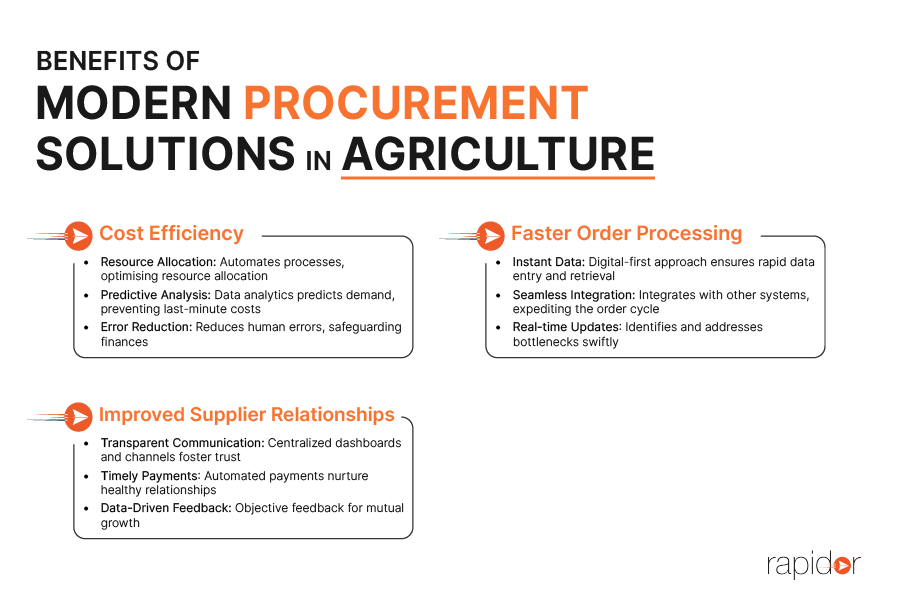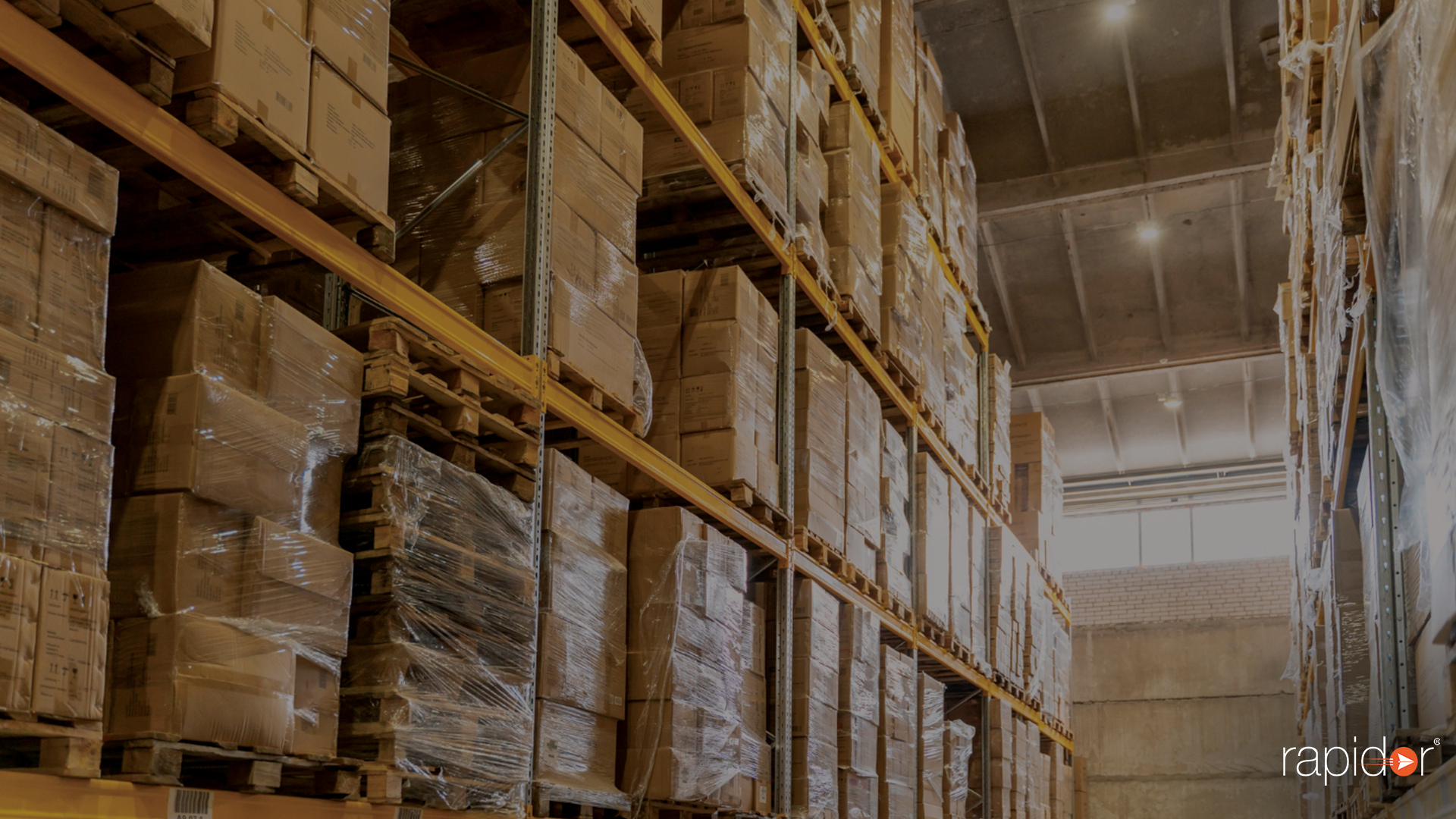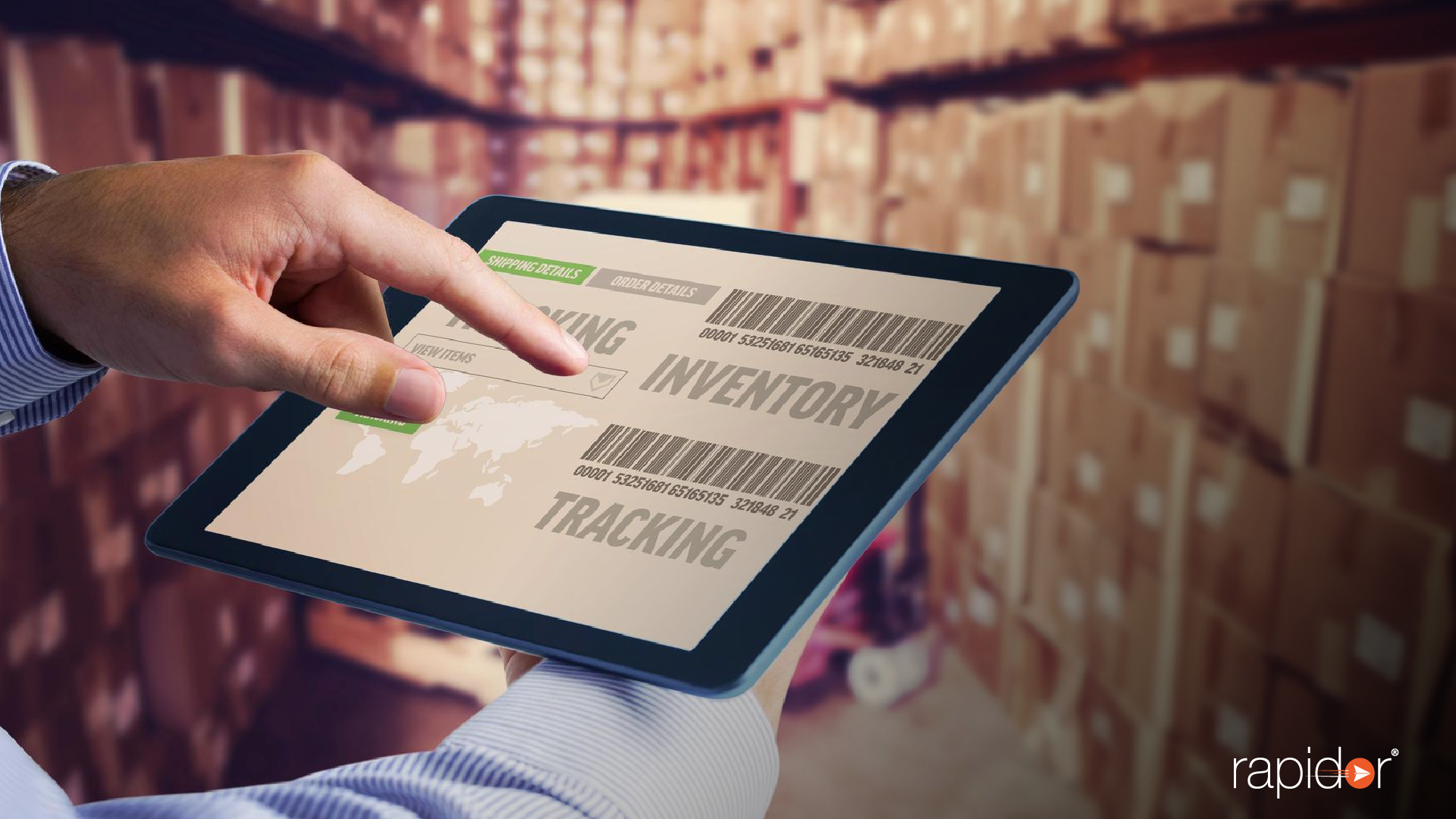The agriculture domain has, for the longest time, leaned on traditional procurement methods. These age-old tactics, while grounded in experience, come with a bevy of limitations.
From manual record-keeping to handshake agreements, traditional procurement often paves the way for inefficiencies, delays, and even financial setbacks. These inefficiencies can become especially detrimental when one considers the tight schedules and slim margins on which many in the agricultural sector operate.
With the global market dynamics becoming more intricate and competitive, relying solely on these outdated systems can no longer sustain modern agriculture demands. This brings to the forefront a pressing question: How can modern procurement solutions intervene and revolutionise the current scenario?
We delve into the transformative potential of tech-driven procurement in agriculture in this guide. The article sheds light on its myriad benefits, from streamlined order-to-cash processes to real-time inventory tracking.
How Important Is Efficient Order Processing In Agriculture?
In the vast and dynamic world of agriculture, efficient order processing plays a pivotal role in determining the success of agribusinesses.
However, the unique challenges that permeate this sector, like the inevitable seasonality of crops, render it susceptible to operational hiccups. With the shifting of seasons comes the change in produce availability, and the need to handle, store, and ship products in a timely manner to avoid spoilage.
Moreover, securing the right equipment at the right time is a game-changer in ensuring crops are planted, nurtured, and harvested effectively. This is where modern order processing can play a vital role.
What is the Need for Modern Procurement Solutions in Agriculture?
Agriculture, often termed the backbone of many economies, is a sector deeply rooted in tradition.
However, with evolving global demands and increasing complexities, the industry now stands at an intersection. Now, tradition must embrace modernization to remain relevant and efficient.
One area in dire need of this modern touch is agricultural procurement. Here, we’ll uncover the specific pain points in this area and reveal how modern procurement solutions are the need of the hour.
Inefficiencies and Delays:
Traditional agricultural procurement often operates on legacy systems or, in some cases, pure manual labour. This not only slows down the order processing but also introduces room for errors.
From recording orders in handwritten ledgers to relying on human memory for inventory checks, these methods are far from foolproof.
The result? Delayed orders, unfulfilled demands, and a chain reaction of inefficiencies down the supply chain.
Lack of Real-Time Inventory Tracking :
In a sector where products have a limited shelf life, real-time inventory tracking is not just a luxury but a necessity. Without modern solutions, farmers and agribusiness owners grapple in the dark.
Thus, resulting in overstocking or understocking, both of which have financial implications and can lead to wastage or missed opportunities.
Inadequate Supplier Collaboration :
Traditional procurement in agriculture often lacks a centralised system for communication. This means suppliers, farmers, and other stakeholders function in silos, leading to miscommunication, misunderstanding, and missed chances for optimization.
Modern procurement solutions offer platforms where all stakeholders can interact seamlessly, building trust and enhancing collaboration.
Lack of Predictive Analysis :
The agriculture sector, with its dependency on seasons, weather, and other unpredictable factors, can significantly benefit from predictive analytics. Traditional methods, however, offer no such insights. Modern procurement solutions harness the power of data, allowing businesses to forecast demands, anticipate challenges, and strategize accordingly.
Manual Errors and Financial Setbacks :
Human errors, an inherent trait of manual processes, can have ripple effects in agricultural procurement. A simple miscalculation or oversight can lead to financial losses, missed delivery dates, or incorrect orders.
Automated order-to-cash processes, a cornerstone of modern procurement solutions, mitigate these risks, ensuring accuracy, reliability, and cost-effectiveness.
What are the Key Features of Modern Procurement Solutions for Agriculture?
The agrarian sector is in a phase of transformative evolution, powered by technological advancements that promise efficiency, accuracy, and scalability. Modern procurement solutions, tailor-made for agriculture, are at the forefront of this transformation.
These solutions are armed with features that directly address the unique challenges of the industry, revolutionising the way agribusinesses operate. Let’s delve deeper into some of these key features:
What Do Automated Order-to-Cash Processes Guarantee?
Efficiency & Accuracy
Gone are the days when order entries, invoicing, and cash collection were laboriously done by hand or through disjointed systems. Modern procurement solutions integrate automated order-to-cash processes, drastically reducing the time taken from order placement to payment receipt.
This not only accelerates the business cycle but also minimises the scope for manual errors.
Optimised Cash Flow
Automation ensures that invoices are dispatched on time, reminders are set for payments, and discrepancies are flagged immediately. This results in a more predictable and optimised cash flow, essential for the cyclical and often capital-intensive nature of agriculture.
Enhanced Customer Experience
With quick, error-free order processing and billing, customers enjoy a seamless experience, which in turn fosters loyalty and long-term business relationships.
How Does Real-time Inventory Tracking Help?
Minimise Wastage
Agriculture produce, being perishable, demands meticulous inventory management. With real-time tracking, agribusinesses can monitor their stock levels instantaneously, ensuring that produce doesn’t overstay its welcome and lead to wastage.
Informed Decision-making
Real-time data empowers businesses to make on-the-spot decisions about restocking, distribution, and sales strategies, preventing stock outs or overstock situations.
Financial Efficiency
Accurate inventory data prevents over-investment in stock and helps allocate resources where they’re most needed, ensuring financial prudence.
How Crucial Is Vendor and Supplier Management?
Centralised Communication
Modern procurement platforms offer a unified dashboard where businesses can communicate directly with vendors and suppliers. This centralised approach eradicates miscommunications and streamlines operations.
Performance Tracking
With integrated analytics, agribusinesses can track the performance of vendors, monitoring delivery times, product quality, and compliance. This ensures accountability and facilitates informed choices for future collaborations.
Strengthened Relationships
Effective vendor and supplier management translates into strengthened partnerships. By streamlining communication, payments, and feedback, trust is nurtured, laying the foundation for lasting business relations.

What are the Benefits of Implementing Modern Procurement Solutions in Agriculture?
Modern procurement solutions are rapidly becoming the backbone of advanced agricultural practices, merging the age-old wisdom of farming with the efficiency of today’s technology. As the agricultural landscape becomes more intricate, these tech-driven solutions prove invaluable.
Here’s a closer look at the manifold benefits that arise from their implementation:
How Does Cost-efficiency Help?
Optimised Resource Allocation
By automating and streamlining numerous processes, modern procurement solutions enable agribusinesses to allocate resources more judiciously. Whether it’s reducing manpower in data entry or minimising wastage through real-time inventory tracking, these solutions pave the way for significant cost savings.
Predictive Analysis
Harnessing the power of data analytics, these systems can predict demand surges or dips, helping businesses plan purchases and sales accordingly. This proactive approach prevents costly last-minute adjustments or emergency measures.
Reduction in Manual Errors
Automated order-to-cash processes and digital record-keeping substantially reduce the room for human errors, which can often lead to financial setbacks. By ensuring accuracy at every step, these solutions safeguard the business’s bottom line.
How Importance is Faster Order Processing Times?
Instantaneous Data Entry and Retrieval
Modern procurement solutions thrive on instantaneousness. Whether it’s logging an order, checking inventory, or generating an invoice, the digital-first approach ensures rapid processing, eliminating tedious manual steps.
Seamless Integration with Other Systems
These platforms often integrate seamlessly with other business systems, be it sales, logistics, or finance. This interconnectedness means that data flows smoothly from one process to another, expediting the overall order cycle.
Real-time Updates
With real-time tracking and updates, any bottlenecks or issues in order processing are immediately identified and addressed, ensuring that orders move swiftly from placement to delivery.
What Do Improved Supplier Relationships Mean?
Transparent Communication
One of the hallmarks of modern procurement solutions is the emphasis on transparent communication. With centralised dashboards and communication channels, suppliers are always in the loop, fostering trust and understanding.
Timely Payments and Reconciliations
Automated financial processes ensure that suppliers are paid punctually, a key factor in nurturing healthy business relationships. Moreover, any discrepancies in billing or payments can be swiftly addressed through the system, preventing conflicts.
Data-Driven Feedback
Performance analytics allow businesses to provide constructive feedback to suppliers. This data-driven approach ensures that feedback is objective, actionable, and geared towards mutual growth.
How to Adopt Modern Procurement Solutions in Agriculture?
In an era where technology is shaping every sector, agriculture, too, stands on the cusp of a digital revolution. The heart of this transformation lies in modern procurement solutions, designed to bring efficiency, transparency, and scalability.
However, the journey from traditional methods to tech-driven processes requires careful planning and execution. Here’s a step-by-step guide to adopting these advanced solutions:
How to Identify Your Needs?
Audit Current Processes
Before diving into the world of digital procurement, take stock of your current operations. Identify bottlenecks, inefficiencies, and areas that demand improvement.
List Functional Requirements
Every agribusiness is unique. Whether you need real-time inventory tracking, automated order-to-cash processes, or advanced vendor management, list down functionalities that align with your business objectives.
How to Research and Shortlist Vendors?
Market Survey
With numerous modern procurement platforms available, initiate with a broad market survey. This will give you a sense of available features, scalability options, and technological advancements.
User Reviews and Case Studies
Peer reviews offer invaluable insights. Seek out testimonials or case studies from businesses similar to yours to understand the practical applications and benefits of the software.
Why Should You Request Demonstrations and Trials?
Hands-on Experience
Most vendors offer product demos or trial periods. Utilise this to get a hands-on feel of the software, assess its user-friendliness, and determine if it meets your specific needs.
Engage Key Stakeholders
Involve team members who’ll be using the platform regularly in these trials. Their feedback, from a user’s perspective, is crucial.
How to Evaluate Cost and ROI?
Total Cost of Ownership
Beyond the initial purchase or subscription cost, consider other expenses such as customization, integration, or future upgrades.
Anticipate ROI
While modern procurement solutions demand investment, they promise substantial returns, be it through time savings, reduced errors, or streamlined operations. Ensure that the chosen platform offers a favourable ROI in the foreseeable future.
How Important Is Implementation and Integration?
Phase-wise Rollout
Instead of a complete overhaul, consider a phased approach. Start with one department or process, gather feedback, and then expand to other areas.
Seamless Integration
Ensure that the chosen solution integrates smoothly with other existing systems, be it sales, logistics, or finance.
How to Ensure Proper Training and Change Management?
Comprehensive Training
A tool is only as effective as its user. Invest in comprehensive training sessions to ensure your team is well-acquainted with the software.
Manage Resistance
Change often meets resistance. Address concerns, showcase the tangible benefits of the new system, and foster a culture that embraces innovation.
Continuous Feedback Loop
As your team interacts with the new system, create channels for continuous feedback. This will help in addressing issues promptly and making necessary adjustments.
How Can You Review and Iterate?
Performance Analytics
Use the built-in analytics of the platform to gauge its efficiency, areas of improvement, and overall impact on business operations.
Stay Updated
The tech landscape is ever-evolving. Stay in touch with your vendor, attend product update sessions, and ensure your solution remains future-ready.
How will the Digital Age Change Agriculture?
The agricultural sector, as ancient as time itself, has been the linchpin of civilizations, economies, and livelihoods. However, with the dawning of the digital age, the need for efficiency, accuracy, and scalability in this sector has grown exponentially.
Modern procurement solutions emerge as a beacon in this context, marrying the wisdom of agrarian practices with the prowess of technology.
In our journey through this discourse, we’ve unravelled the manifold advantages of these advanced solutions. From cost-efficiency, streamlined order-to-cash processes, and real-time inventory tracking to fostering improved supplier relationships, these platforms offer a comprehensive toolkit to revolutionise agribusiness operations.
The ripple effects of such advancements not only touch the business’s bottom line but also enhance the overall agricultural value chain, ensuring sustainability, profitability, and resilience.
If you find yourself grappling with inefficiencies, delays, or the sheer weight of manual processes in your order processing systems, it’s a clarion call to consider a transition. The best time to embrace modern procurement in agriculture is today.
So, take the leap, innovate, and be part of the next agrarian revolution.


